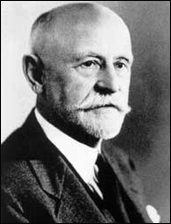James Herrick, MD
1861 — 1954

James Herrick was born in Chicago (Oak Park) and educated at the University of Michigan, University of Chicago (LLD) and Northwestern University (MD) and for many years was professor at Rush Medical College. He was also active in organized medicine and an author. (A Short History of Cardiology in 1942).
Herrick figures strongly in the history of cardiology, and in this history of CVD prevention, by his classic contribution to recognition of the syndrome of myocardial infarction with survival, that is, coronary disease beyond angina pectoris and sudden death. It had been previously described but not accepted or well-established that people might recover with more and less damage and live productive lives after a heart attack. He successfully and indelibly joined the clinical, electrocardiographic, and pathological findings of cardiac infarction.
With modest scholarship, in 1942, long after his seminal presentation before the American Medical Association in 1912, he wrote: “These facts had been written before. They had to be rediscovered. . . . When it was presented, it was discussed by only one person, there was no repercussion for six years. It had fallen like a dud.”
Historians give Herrick credit, along with Obrastzow and Straschesko in Europe in 1910, for modern understanding of cardiac infarction, and, for that matter, allowing recognition of the epidemic nature of coronary disease following World War II. (HB)
Sources
James, T.N., 2000. Homage to James B. Herrick: a contemporary look at myocardial infarction and at sickle-cell heart disease: the 32nd Annual Herrick Lecture of the Council on Clinical Cardiology of the American Heart Association. Circulation, 101(15): 1874-87.